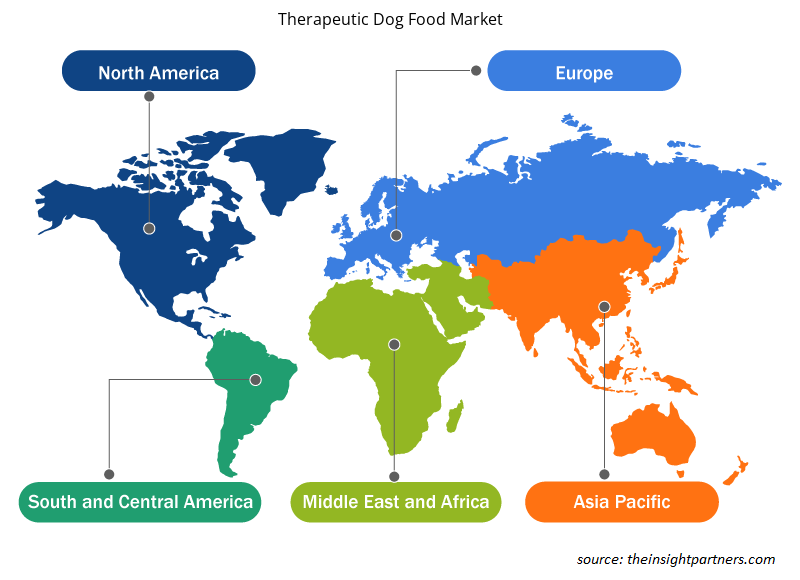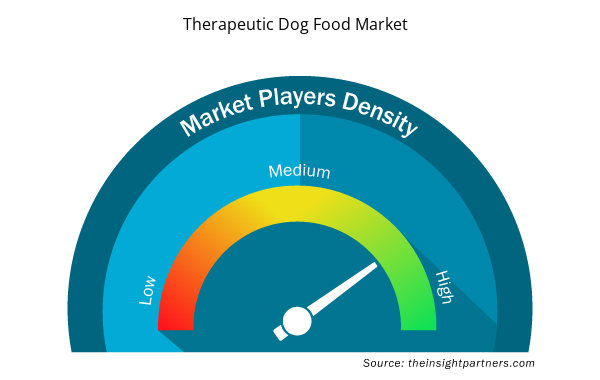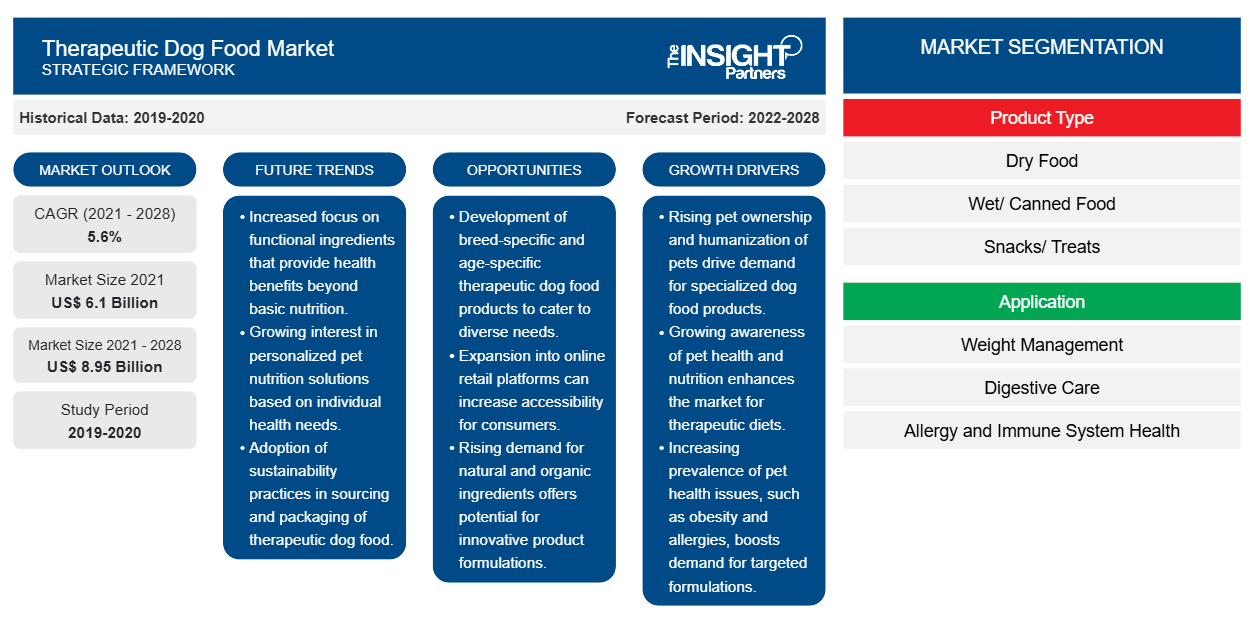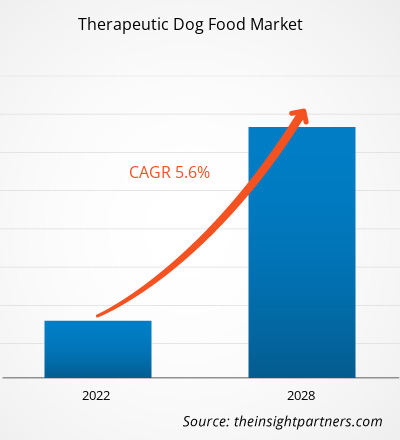治疗性狗粮市场规模预计将从 2021 年的 60.957 亿美元增至 2028 年的 89.4952 亿美元;预计 2021 年至 2028 年的复合年增长率为 5.6%。
治疗性狗粮是专门为治疗各种疾病而配制的。这些饮食也用于治疗皮肤瘙痒、消化问题、肥胖、过敏和热病等。宠物食品制造商正在不断改变其产品种类,使其适合宠物的健康。
治疗性狗粮市场根据产品类型、应用和地理位置进行细分。按地理位置划分,市场大致分为北美、欧洲、亚太地区、中东和非洲以及南美和中美。该报告提供了对市场的见解和深入分析,强调了市场趋势、技术进步和市场动态等参数,以及对全球领先市场参与者的竞争格局的分析。
定制此报告以满足您的需求
您可以免费定制任何报告,包括本报告的部分内容、国家级分析、Excel 数据包,以及为初创企业和大学提供优惠和折扣
- 获取此报告的关键市场趋势。这个免费样品将包括数据分析,从市场趋势到估计和预测。
市场洞察
越来越多人收养陪伴犬,推动治疗性狗粮市场增长
狗被认为是人类的合适伴侣,因为它们对主人的生活有着重大影响。它们促进积极的生活方式,并能在实际发病前检测到即将发生的癫痫发作。宠物有助于儿童的社交、情感和认知发展,此外还能帮助成年人缓解压力和焦虑。研究表明,养狗的人死于心血管疾病的风险降低 36%,患心脏病的风险降低 11%。根据美国宠物产品协会 2019-2020 年的调查,美国约有 6340 万户家庭至少拥有一只狗。此外,根据代表欧洲宠物食品行业的机构 FEDIAF 的数据,狗在该地区越来越受欢迎;欧盟的宠物狗数量从 2016 年的 6370 万只增加到 2017 年的 6640 万只。根据人民动物诊所 (PDSA) 的《2019 年动物福利 (PAW) 报告》,英国约 50% 的人口拥有宠物,宠物狗数量估计为 990 万只。该国 26% 的成年人拥有狗。因此,人们对狗作为伴侣的偏好不断增加,推动了治疗性狗粮市场的增长。
狗慢性病患病率不断上升,显著促进治疗性狗粮市场增长
与人类一样,动物也会患慢性疾病。关节炎、慢性肾病、癌症、肝炎和其他肝病、皮肤过敏和糖尿病是宠物中常见的慢性疾病。癌症在动物中很普遍,也会影响狗。根据兽医癌症协会的数据,癌症是 47% 的狗(尤其是年龄超过 10 岁的狗)死亡的主要原因。此外,根据宠物癌症事实和数据,每四只狗中就有一只在其一生中患上癌症。根据宠物肥胖预防协会 (APOP) 的数据,2018 年美国约有 55.8% 的狗超重或肥胖。关节炎基金会表示,约 20% 的成年犬患有关节炎。慢性疾病患病率的不断上升已成为狗主人的主要担忧,这凸显了对适当护理的需求。因此,随着狗慢性疾病患病率的上升,公司正专注于提供先进的治疗性食品,以帮助狗主人维持宠物的整体健康。
产品类型洞察
根据产品类型,全球治疗性狗粮市场细分为干粮、湿粮/罐头食品、零食/点心和其他。2020 年,干粮部分占据了最大的市场份额。此外,零食/点心部分预计将在 2021-2028 年期间实现市场上最高的复合年增长率。干粮被认为对牙齿健康有益。在某些情况下,它们可以减少牙结石(牙垢)。干粮或罐头食品的选择取决于宠物主人的喜好和成本,除非宠物需要更高的液体摄入量(例如患有慢性肾病的猫或患有尿石的宠物),预计这将在预测期内推动市场发展。
应用程序洞察
根据应用,治疗性狗粮市场细分为体重管理、消化保健、过敏和免疫系统健康等。体重管理部分将在 2021 年占据最大的市场份额。此外,消化保健部分预计未来将在治疗性狗粮市场中占据相当大的市场份额。最近,在 2021 年 1 月,领先的 WellPet 品牌 Wellness Natural Pet Food 推出了一系列针对狗和猫消化健康的功能性宠物食品配方。Wellness CORE Digestive Health 具有消化酶、益生元纤维和益生菌,以支持肠道健康。这些发展可能会推动消化保健部分的治疗性狗粮市场增长。
产品发布和并购是全球治疗性狗粮市场参与者广泛采用的策略。以下列出了一些近期的关键市场发展:
- 2021年7月,通用磨坊以12亿美元现金收购了泰森食品的宠物零食业务。该业务包括Nudges、Top Chews和True Chews产品类别,是宠物天然肉类零食行业的领导者。
- 2021 年 8 月,WellPet, LLC 宣布推出几款新的宠物食品和零食产品,包括专门针对幼犬、小猫和老年宠物的配方。
根据保险研究委员会 2020 年 10 月的报告,在 COVID-19 期间,约 30% 的美国人由于对陪伴的需求增加而收养了宠物。此外,根据德国养犬俱乐部 (VDH) 的数据,2020 年购买的狗数量比上一年增加了约 20%。市场上的大多数消费者都在努力应对疫情的爆发。由于实体店受到多项限制以及整体供应渠道中断,零售和电子商务平台实现了高速增长。几家在线零售商报告宠物产品销售强劲。例如,Chewy.com 自 2020 年 2 月以来销售加速。该公司通过订阅客户实现约 70% 的销售额。这些条件为未来几年治疗性狗粮市场的增长提供了有利可图的机会。
治疗性狗粮——市场细分
治疗性狗粮市场按产品类型、应用和地域进行细分。就产品类型而言,市场细分为干粮、湿粮/罐头食品、零食/零食和其他。根据应用,治疗性狗粮市场细分为体重管理、消化保健、过敏和免疫系统健康和其他。按地域划分,市场大致分为北美、欧洲、亚太地区、中东和非洲以及南美和中美洲。
治疗性狗粮市场区域洞察
Insight Partners 的分析师已详细解释了预测期内影响治疗性狗粮市场的区域趋势和因素。本节还讨论了北美、欧洲、亚太地区、中东和非洲以及南美和中美洲的治疗性狗粮市场细分和地理位置。

- 获取治疗性狗粮市场的区域特定数据
治疗性狗粮市场报告范围
| 报告属性 | 细节 |
|---|---|
| 2021 年市场规模 | 61亿美元 |
| 2028 年市场规模 | 89.5亿美元 |
| 全球复合年增长率(2021 - 2028) | 5.6% |
| 史料 | 2019-2020 |
| 预测期 | 2022-2028 |
| 涵盖的领域 | 按产品类型
|
| 覆盖地区和国家 | 北美
|
| 市场领导者和主要公司简介 |
|
治疗性狗粮市场参与者密度:了解其对业务动态的影响
治疗性狗粮市场正在快速增长,这得益于终端用户需求的不断增长,而这些需求又源于消费者偏好的不断变化、技术进步以及对产品优势的认识不断提高等因素。随着需求的增加,企业正在扩大其产品范围,进行创新以满足消费者的需求,并利用新兴趋势,从而进一步推动市场增长。
市场参与者密度是指在特定市场或行业内运营的企业或公司的分布情况。它表明在给定市场空间中,相对于其规模或总市场价值,有多少竞争对手(市场参与者)存在。
在治疗性狗粮市场运营的主要公司有:
- 玛氏公司
- 雀巢
- 希尔宠物营养有限公司
- JM Smucker 公司
- 通用磨坊股份有限公司
免责声明:上面列出的公司没有按照任何特定顺序排列。

- 获取治疗性狗粮市场顶级关键参与者概述
公司简介
- 玛氏公司
- 雀巢
- 希尔宠物营养有限公司
- JM Smucker 公司
- 通用磨坊股份有限公司
- 安妮蒙达
- 达尔文宠物
- 谢尔与坎彼得公司
- 宠物护理公司
- 比法尔
- 宠物
- 历史分析(2 年)、基准年、预测(7 年)及复合年增长率
- PEST 和 SWOT 分析
- 市场规模价值/数量 - 全球、区域、国家
- 行业和竞争格局
- Excel 数据集



Report Coverage
Revenue forecast, Company Analysis, Industry landscape, Growth factors, and Trends

Segment Covered
This text is related
to segments covered.

Regional Scope
North America, Europe, Asia Pacific, Middle East & Africa, South & Central America

Country Scope
This text is related
to country scope.
常见问题
Initiatives by governments and private players is likely to fuel the market growth in the coming years
Product innovations is likely to act as trend the market growth in the coming years.
Dry food segment is growing in the therapeutic dog food market.
Key players in the market are Mars, Incorporated, Nestlé, Hill's Pet Nutrition, Inc., The J. M. Smucker Company, GENERAL MILLS, INC., ANIMONDA, DARWIN PET, SCHELL & KAMPETER, INC., AFFINITY PETCARE S.A, Beaphar, and WellPet among others.
Key factors driving the growth of the market are increasing adoption of dogs for companionship, growing prevalence of chronic diseases among dogs, and surge in launch of therapeutic dog food products drive the market growth. However, low sales in developing countries hampers the market growth.
Therapeutic dog food comprises of specifically formulated to aid in the management of illness and disease. These diets are formulated to treat a variety of problems such as itchy skin, digestive issues, obesity, allergies, and heat diseases.
Asia-Pacific is the lucrative for the therapeutic dog food market.
Trends and growth analysis reports related to Food and Beverages : READ MORE..
The List of Companies - Therapeutic Dog Food Market
- Mars, Incorporated
- Nestlé
- Hill's Pet Nutrition, Inc.
- The J. M. Smucker Company
- GENERAL MILLS, INC.
- ANIMONDA
- DARWIN PET
- SCHELL & KAMPETER, INC.
- AFFINITY PETCARE S.A
- Beaphar
- WellPet
The Insight Partners performs research in 4 major stages: Data Collection & Secondary Research, Primary Research, Data Analysis and Data Triangulation & Final Review.
- Data Collection and Secondary Research:
As a market research and consulting firm operating from a decade, we have published and advised several client across the globe. First step for any study will start with an assessment of currently available data and insights from existing reports. Further, historical and current market information is collected from Investor Presentations, Annual Reports, SEC Filings, etc., and other information related to company’s performance and market positioning are gathered from Paid Databases (Factiva, Hoovers, and Reuters) and various other publications available in public domain.
Several associations trade associates, technical forums, institutes, societies and organization are accessed to gain technical as well as market related insights through their publications such as research papers, blogs and press releases related to the studies are referred to get cues about the market. Further, white papers, journals, magazines, and other news articles published in last 3 years are scrutinized and analyzed to understand the current market trends.
- Primary Research:
The primarily interview analysis comprise of data obtained from industry participants interview and answers to survey questions gathered by in-house primary team.
For primary research, interviews are conducted with industry experts/CEOs/Marketing Managers/VPs/Subject Matter Experts from both demand and supply side to get a 360-degree view of the market. The primary team conducts several interviews based on the complexity of the markets to understand the various market trends and dynamics which makes research more credible and precise.
A typical research interview fulfils the following functions:
- Provides first-hand information on the market size, market trends, growth trends, competitive landscape, and outlook
- Validates and strengthens in-house secondary research findings
- Develops the analysis team’s expertise and market understanding
Primary research involves email interactions and telephone interviews for each market, category, segment, and sub-segment across geographies. The participants who typically take part in such a process include, but are not limited to:
- Industry participants: VPs, business development managers, market intelligence managers and national sales managers
- Outside experts: Valuation experts, research analysts and key opinion leaders specializing in the electronics and semiconductor industry.
Below is the breakup of our primary respondents by company, designation, and region:

Once we receive the confirmation from primary research sources or primary respondents, we finalize the base year market estimation and forecast the data as per the macroeconomic and microeconomic factors assessed during data collection.
- Data Analysis:
Once data is validated through both secondary as well as primary respondents, we finalize the market estimations by hypothesis formulation and factor analysis at regional and country level.
- Macro-Economic Factor Analysis:
We analyse macroeconomic indicators such the gross domestic product (GDP), increase in the demand for goods and services across industries, technological advancement, regional economic growth, governmental policies, the influence of COVID-19, PEST analysis, and other aspects. This analysis aids in setting benchmarks for various nations/regions and approximating market splits. Additionally, the general trend of the aforementioned components aid in determining the market's development possibilities.
- Country Level Data:
Various factors that are especially aligned to the country are taken into account to determine the market size for a certain area and country, including the presence of vendors, such as headquarters and offices, the country's GDP, demand patterns, and industry growth. To comprehend the market dynamics for the nation, a number of growth variables, inhibitors, application areas, and current market trends are researched. The aforementioned elements aid in determining the country's overall market's growth potential.
- Company Profile:
The “Table of Contents” is formulated by listing and analyzing more than 25 - 30 companies operating in the market ecosystem across geographies. However, we profile only 10 companies as a standard practice in our syndicate reports. These 10 companies comprise leading, emerging, and regional players. Nonetheless, our analysis is not restricted to the 10 listed companies, we also analyze other companies present in the market to develop a holistic view and understand the prevailing trends. The “Company Profiles” section in the report covers key facts, business description, products & services, financial information, SWOT analysis, and key developments. The financial information presented is extracted from the annual reports and official documents of the publicly listed companies. Upon collecting the information for the sections of respective companies, we verify them via various primary sources and then compile the data in respective company profiles. The company level information helps us in deriving the base number as well as in forecasting the market size.
- Developing Base Number:
Aggregation of sales statistics (2020-2022) and macro-economic factor, and other secondary and primary research insights are utilized to arrive at base number and related market shares for 2022. The data gaps are identified in this step and relevant market data is analyzed, collected from paid primary interviews or databases. On finalizing the base year market size, forecasts are developed on the basis of macro-economic, industry and market growth factors and company level analysis.
- Data Triangulation and Final Review:
The market findings and base year market size calculations are validated from supply as well as demand side. Demand side validations are based on macro-economic factor analysis and benchmarks for respective regions and countries. In case of supply side validations, revenues of major companies are estimated (in case not available) based on industry benchmark, approximate number of employees, product portfolio, and primary interviews revenues are gathered. Further revenue from target product/service segment is assessed to avoid overshooting of market statistics. In case of heavy deviations between supply and demand side values, all thes steps are repeated to achieve synchronization.
We follow an iterative model, wherein we share our research findings with Subject Matter Experts (SME’s) and Key Opinion Leaders (KOLs) until consensus view of the market is not formulated – this model negates any drastic deviation in the opinions of experts. Only validated and universally acceptable research findings are quoted in our reports.
We have important check points that we use to validate our research findings – which we call – data triangulation, where we validate the information, we generate from secondary sources with primary interviews and then we re-validate with our internal data bases and Subject matter experts. This comprehensive model enables us to deliver high quality, reliable data in shortest possible time.


 获取此报告的免费样本
获取此报告的免费样本